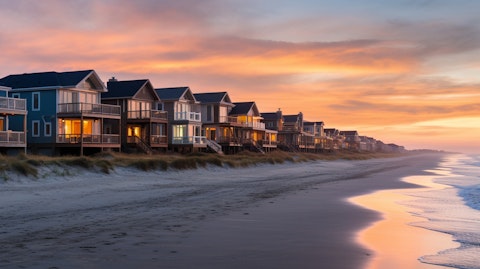Vacasa, Inc. (NASDAQ:VCSA) Q4 2023 Earnings Call Transcript February 28, 2024
Vacasa, Inc. isn’t one of the 30 most popular stocks among hedge funds at the end of the third quarter (see the details here).
Operator: Good morning. My name is Stephanie and I will be your conference operator today. At this time, I would like to welcome everyone to Vacasa Fourth Quarter 2023 earnings conference call. All lines have been placed on mute to prevent any background noise. After the speaker’s remarks, there will be a question-and-answer session. [Operator Instructions] I would now like to turn the conference over to Jay Gentzkow, Vice President Investor Relations. Please go ahead.
Jay Gentzkow: Good afternoon, everyone, and thank you for joining us for today’s call. I’m pleased to be joined today by Vacasa’s CEO, Rob Greyber; and CFO, Bruce Schuman. As a reminder, the content of today’s call is the property of Vacasa and may not be reproduced or transcribed without our written consent. We have posted a shareholder letter on the Investor Relations section of our website at investors.vacasa.com and will be referenced by our speakers. Comments made during this conference call and in our shareholder letter contain forward-looking statements. Such statements include those about future expectations, beliefs, plans, projections, strategies, targets, estimates, objectives, events, conditions and financial performance, including guidance for future period results.
We caution you that various risks and uncertainties could cause actual results to differ materially from those in our forward-looking statements. For additional information concerning these risks and uncertainties please read the forward-looking statements section in the shareholder letter we issued earlier today and the forward-looking statements and risk factors section in our filings with the Securities and Exchange Commission. During this call we may refer to various non-GAAP financial measures. Information regarding our non-GAAP financial results including a reconciliation of our non-GAAP results to the most directly comparable GAAP financial measures may be found in our shareholder letter. These non-GAAP measures should be considered in addition to our GAAP results and are intended to supplement but not substitute for performance measures calculated in accordance with GAAP.
And now, I will turn the call over to Rob Greyber. Rob?
Rob Greyber: Thanks Jay. Good afternoon, everyone, and thank you for joining us. I’ll begin today with a recap on 2023 and then turn to how we’re positioning Vacasa in 2024 and beyond. I’ll then hand the call to Bruce to review financial results. Before that, I wanted to note that today we shared with our team that we decided to reduce our head count impacting around 320 people representing about 5% of our workforce. Decisions like this are always difficult and this was no exception. As we have shared before, we are on a path to transform the process to become a more efficient, high-performing organization, one dedicated to the service of our owners, our guests and the people who serve them. On that path to transformation, 2023 was a pivotal year for the company.
We concentrated on building a better, more efficient business against the dynamic macroeconomic and industry environment. We sharpened our organic sales engine, accelerated product delivery and improved our cost structure. This allowed us to deliver an adjusted EBITDA profitable year despite double digit declines in gross booking value per home across the industry on a year-on-year basis. 2023 had its challenges and we made a great deal of progress in the business yet 2024 is off to a difficult start and it remains much more to accomplish in an industry environment that remains challenging. In 2023, we made it our mission to focus on improving the owner experience. We visited local markets and examine how we care for homes and destinations across the country.
We surveyed and listened to homeowners and analyzed our internal processes. We delivered a number of new technology tools to make our value proposition to homeowners stronger than ever. From previous calls we’ve discussed the homecare dashboard like the SMS tool and clean inspection tool. We believe these products are significantly improving the homeowner experience as reflected in owner feedback we’ve received since implementation, in the fourth quarter we also launched our homeowner communication tool allowing owners to interact with our teams directly through our mobile apps and owner portals. We also introduced our proprietary market rates comparison tool, which gives our owners insights into how the price stays at their homes and allows them to model certain criteria to see how changes might impact their revenue.
As a result of these initiatives and our team’s relentless efforts on our homeowner experience, our homeowner satisfaction scores improved steadily through the second half of the year. So we are seeing positive trends in homeowner satisfaction, but we have not yet turned the corner on churn. Some aspects of churn are an industry phenomenon, but many are in our control. Improving the homeowner experience including how we care for their guests is central to those efforts and homeowner retention will remain a critical priority throughout 2024. A few words about how we performed against the four critical priorities, I shared with you all last year which were; improving execution in local markets and customer support functions, unlocking the potential of the individual sales approach, developing the right technology products and prioritizing our business needs to drive profitable growth.
We spent last year improving how we support and operate in our local markets. We implemented new processes enabled by technology, created efficiencies without sacrificing the service level excellence our homeowners and guests expect. For example, midway through 2023, we began rolling out our new field scheduling system. This tool is designed to optimize one of our most time consuming and expensive task, physical visits to homes. The effectiveness of this tool will help drive our highest guest reviews for the year in Q4, and our highest cleanliness and Net Promoter Scores of 2023 across all major channels, all while driving efficiencies that led to year-over-year cost savings in Q4, including a 7% reduction in the cost of revenue per Night Sold and a 13% reduction in operations and support expense.
Turning to our sales efforts, entering 2023, we moved away from the portfolio acquisition approach toward our individual approach, with the goal of improving our ability to consistently and sustainably add desirable homes to our platform over the long-term. As part of this shift in strategy, we implemented a number of initiatives to streamline our organic sales processes and productivity and strengthen our team. We restructured the sales organization to drive our efficiency emphasizing organic sustainable home growth. We also redesigned sales incentive plans to better align performance and results, and improved our tools and systems to drive efficiencies in our sales enablement processes and owner and home onboarding, among other initiatives.
Traction on these initiatives helped drive three consecutive quarters of year-over-year improvement in sales productivity to end 2023. We continue to add functionality to our technology platform, prioritizing investments that generate measurable efficiencies in our operations and deliver a better experience for homeowners and guests. In addition to the homeowner communications, market rates comparison and field scheduling tools launched in 2023. During Q4, we made several other technology driven improvements. We significantly upgraded our connectivity to Airbnb, enabling us to place critical information for guests directly into the Airbnb app such as Reservation Confirmations, Trip Updates and Departure Instructions. This has reduced the number of calls to our Guest Experience Center and helped drive higher Guest Satisfaction Scores.

We expanded and are ramping, the number of channels through which we offer our homes, for also offering curated inventory on some of those channels to target different types of guests and provide incremental revenue opportunities for our owners. We also continue to introduce Artificial Intelligence tools that improve productivity. The most recent launch in Q4 has greatly reduced the time spent processing guest reviews. This allows us to more quickly identify review that requires an immediate action versus a, positive reviews that may require simple acknowledgments and Thank you. Finally, over the course of 2023, we drove cost efficiencies across the business while carefully managing expense spend, culminating in full year adjusted EBITDA profitability that exceeded our guidance, despite lower year-over-year revenue.
We made it clear that 2023 would be a transition year for Vacasa. A year to reset, improve the organization and position the business for the long-term. 2024 will be a year of continued transformation, to maintain momentum and capitalize on the improvements in 2023. As I mentioned before, 2024 is off to a difficult start. Increased supply in the market as well as softening demand is resulting in continued bookings variability. We are watching those dynamics very closely. However, the current conditions are creating uncertainty as we look forward. Therefore, it is as important as ever to sharpen our focus on execution, zero at FX and raised the tempo on the top initiatives that are going to take the concept to the next stage on our journey. With that dynamic as context, I’d like to outline the strategic priorities that are driving our decision-making for 2024.
We will continue to focus on improving and aligning the Vacasa’s product and technology capabilities for our owners, our guests, and the people who take care of them. We believe leveraging technology will support the superior experience for, and value to, homeowners and guests, while also making our operations more efficient. The team is already hard at work on a number of impactful new developments which I look forward to sharing with you over the coming quarters. Vacasa will also be putting a renewed focus into optimizing our service offerings and where we allocate resources. Adding desirable homes to our platform, while minimizing churn is at the foundation of our long-term growth strategy with the individual sales approach as the primary driver of that growth.
However, against the backdrop of a persistently dynamic industry environment coming off the highs of 2021 and 2022, as well as our continued efforts to prioritize profitability, we will be very intentional with how we allocate resources across the business to drive long-term growth. We intend to prioritize investments in and allocate resources to creating or further leveraging tools to attract and retain homeowners and to explore additional service offerings and ways to monetize our platform. We will be revisiting our progress and strategy here in coming quarters. And finally, while we are focused on our long-term growth opportunities, we are continuing to execute on improving operational effectiveness and efficiencies across the organization.
We made significant progress in this area in 2023, driving an over $50 million improvement in adjusted EBITDA year-over-year, primarily driven by reduced expenses and driving efficiencies throughout our business. We will be laser-focused on this throughout 2024 and beyond as a foundational principle of our culture at the costs. And in closing, we made a lot of progress in 2023, particularly given the headwinds we encountered throughout the year and there is more work to do in a challenging environment. And I believe we are making the right strategic decisions to allow the business to reach its full potential plan focused on continuing this phase of Vacasa’s journey. I’ll now turn the call over to Bruce to discuss financials? Bruce?
Bruce Schuman: Thanks Rob. Unless noted otherwise, I will be comparing our fourth quarter results to the fourth quarter of 2022 and I’ll be referencing the operating expense lines excluding the impact of stock-based compensation, restructuring costs, and business combination costs, which you can find outlined in our shareholder letter. We finished 2023 with approximately 42,000 homes, down 5% year-over-year, reflecting the churn dynamic that we and the broader industry has been experiencing over the past few quarters. For the fourth quarter, gross booking value, which is the combination of nights sold and gross booking value per night sold, was $337 million, down 19% year-over-year. Nights sold were $1.1 million in the fourth quarter, down 5% year-over-year.
Gross booking value per night sold was $309 in the fourth quarter, down 15% year-over-year. Throughout 2023, we’ve discussed the year-over-year declines in average gross booking value per homes as the industry normalizes off of the record highs from the past few years and we saw this dynamic play out again in the fourth quarter. As a reminder, there’s a strong correlation between nights sold and gross booking value per night sold and it’s difficult to look at either in isolation. Our revenue management algorithms and data team constantly evaluate the trade-off between price and occupancy and the mix of nights sold and gross booking value per night sold with the goal of optimizing homeowner income. Revenue, which consist primarily of our commission on the rents we generate for homeowners, the fees we collect from guests, and revenue from home care solutions provided directly to our homeowners, was $177 million in the fourth quarter down 19% year-over-year.
For the full year 2023, gross booking value was $2.3 billion, down 10% year-over-year, primarily due to lower guests demand as traveler demand for domestic non-urban vacation rentals normalizes from the highs of 2021 and 2022. This drove revenue of $1.1 billion for the full year 2023, down 6% year-over-year, in line with our expectations. Now, turning to expenses. Cost of revenue was 58% of revenue in the fourth quarter versus 53% of revenue for the same period last year. Operations and support expense was 33% of revenue in the fourth quarter versus 30% of revenue in the same period last year. These two expense lines, primarily consist of our local market and customer support costs. While cost of revenue and operations and support expense as a percentage of revenue were up on a year-over-year basis in Q4, we decreased cost of revenue dollars by 12% year-over-year and Operations and support expense dollars by 13% year-over-year, while homes on the platform and nights sold both declined 5%.
Our fourth quarter results are a strong example of the progress we are making in operating our local markets in a more efficient manner. We continue to demonstrate operating discipline in our central operations, where we achieved another quarter of year-over-year operating expense leverage in the fourth quarter. This represents four consecutive quarters of year-over-year reductions in our three other operating expense lines, as we continue to drive efficiency gains across our organization. Specifically on a year-over-year basis for Q4, technology and development expense declined 5%, sales and marketing expense declined 18% and general and administrative expenses declined 15%. Adjusted EBITDA was negative $55 million for the fourth quarter compared to negative $49 million in the same period last year.
However, we achieved full year 2023 adjusted EBITDA of $24 million ahead of our expectations shared last quarter and our first full year of adjusted EBITDA profitability of scale. Despite revenue declines of $70 million in 2023 versus 2022, adjusted EBITDA increased over $50 million in the same period. While there is more to do, I believe our ability to drive profitability gains, despite the dynamic industry backdrop speaks to the progress the team is making in advancing our operating discipline. Now turning to 2024. As we detailed throughout 2023 and Rob reiterated in his remarks, we’ve made significant progress establishing a foundation for Vacasa’s long-term success. We’ve improved our operating discipline across the board and have better control of our expense structure in order to position the business for long-term profitable growth and free cash flow generation.
However, as Rob noted 2024 is off to a difficult start. The short-term rental industry continues to adjust to softening demand for domestic nonurban vacation rentals as well as increases in supply of short-term rental units. As a result, we are experiencing continued bookings variability and our expectation for average gross booking value per home continues to be challenged at least in the first half of 2024. This creates significant uncertainty around our view of the coming year. Given these dynamics and their impact on bookings variability, average gross bookings per home as well as continued elevated churn there are a wide range of potential outcomes for 2024. As a result, we do not plan to provide guidance for 2024 until we have better visibility to how this plays out.
However, we intend to continue to aggressively manage our cost structure and to prioritize adjusted EBITDA profitability as well as positive free cash flow generation. We’ll keep you posted in the coming quarters and how these dynamics are playing out and our progress against them. With that Rob and I will take your questions. Operator, please open up the line.
See also 15 Best Shareholder Activism Law Firms and 15 Best Barbecue Chains in America That Are Actually Worth Trying.
Q&A Session
Follow Vacasa Inc.
Follow Vacasa Inc.
Operator: The floor is now open for your questions. [Operator Instructions] Your first question comes from the line of Jed Kelly with Oppenheimer. Your line is open.
Jed Kelly: Great. Thanks for taking my questions. Are realize the brief not behind giving guidance. But can you sort of just give us some trends on the way January and February were? I know that it was I think January targets some industry people is the toughest comps. Can you give us a sense on that? And then just on the softening demand in the opening comments using cash more macro driven or is that still the pattern of travel normalizing? Then I have a follow-up.
Rob Greyber: Terrific. Hey, Jeff. Good to hear from you on. So I’ll share a few thoughts on the overall environment that we’re seeing and kind of trying to share a few thoughts on the demand side as well. So recall that for about a year maybe more than a year now we’ve been talking about the changes that we’ve been observing in the consumer booking kind of dynamic, and that’s been affecting both gross bookings, value per night sold, a number of nights sold and that’s coming off of two record years in 2021 and 2022. So look I think there are a combination of factors that are at play here. I think that there is still a dynamic where there is a shift back to urban and international travel others have referenced that I think consumers are returning to the office or if they’re not, they’re certainly returning to kind of a more normal dynamic in their own lives, where they’re not working remotely for extended period of time.
I think there’s also some potential concerns on the macro side and when you think about the work that the Fed has been doing on maintaining inflation on those things. In the short run I think are terrific in the long – in the long run they’re terrific in the short run they can put some pressure on the customer spending dynamics. So we’ll see how all that plays out. I think in addition to that I would say that we are seeing continued double-digit increases year-over-year in supply in our markets and that has an impact on the demand for film that you’ve seen play out. So when you think about those factors at play. I think those are some of the drivers that we’re watching closely when we think about the bookings pace that we’re seeing at the start of 2024 and it’s a volatile environment.
There’s some of the dynamics we’ve alluded to on the weakness at the close end of the booking curve that we’re observing and navigating. And so when we think about how we’re adapting and working through this environment, this is something that we’ve been seeing for us for a little while. We’re in the process of understanding these new patterns. We’re using that to sort of another motivation to really think about first how to operate efficiency efficiently. And then second how to maximize the income for our homeowners. There’s a lot of work that we are doing on those fronts. And I think that we’ve shown our ability to navigate some of those challenges for example in the fourth quarter with cost of revenue per night and operations and support expense coming down on a year-over-year basis.
So we’re working hard to adapt to these new changes. We did that in 2023. We have to do it again in 2024. There’s not really a blueprint here but it reinforces that focus on execution and tactics which is really an important driver of our performance in the long run. So okay, as I think about it consumer, demand is going to ebb and flow in our vertical and it’s going to be driven by preference shifts within travel or a broader economic environment. But we think we’re focused on the right things by focusing on our local market operations being nimble, being thoughtful, variabilizing our costs and then staying very focused on navigating on our front foot via the changes. The changes in demand. Your other question on demand was…
Jed Kelly: Just on the monthly trends that you could share anything like January, February and then in January, the toughest comp?
Rob Greyber: Yes, we’re not going to parse the monthly dynamically Jed. We’re clearly watching it. It’s difficult for us to call that out especially. I think what we’re trying to be as open as we can about what it is that we’re observing. I think you’ve seen us do that before. I think that there’s a lot of industry data sources that are suggesting that it is – the dynamics are something that the broad market are seeing and I think that it’s probably all of the same drivers.
Jed Kelly: Got it. And then just as a follow-up, saw you gave 42,000 homes. Are you planning to give that metric quarterly? And is that kind of a sign that churn is maybe stabilizing a little bit Thanks.
Bruce Schuman: Yes. Hi, Jed. This is Bruce. Thanks for the question. I’ll take the first part of that and then maybe Rob can talk to the churn dynamic. The short answer to your question is yes, we do plan on disclosing that on a quarterly basis. Just for the simple reason that number one, it’s an important financial metric for us. And we think just as a matter of transparency for investors I think that’s important to disclose, so we are going to be doing that on it on an ongoing basis.
Rob Greyber: In terms of the churn dynamic, we do a broad kind of talk through our progress there and what we’re doing to try to get that more under control.
Bruce Schuman: Yes, Jed. So look I’m sure the reality is – it’s not – it’s not where we wanted to be. There’s a dynamic here that is still settling across the industry. We’re focused on the key things that we hear from owners. We’ve shared those with you before on homeowner communications and on rates and revenue. I would say that we’ve been we’ve been investing. We’ve been focusing our work and we’ve seen some of these leading indicators move in the right direction, but we’re not yet — we’ve not yet seen that the end result which is churn move you move to where we wanted to be. So, on the drivers, the focus on the homeowner experience that you’ve heard us talk about has led directly to steadily improving owner NPS, which has always been a key leading indicator for us and we haven’t seen it turn that back quarter, but it’s been a big area of focus for us.



